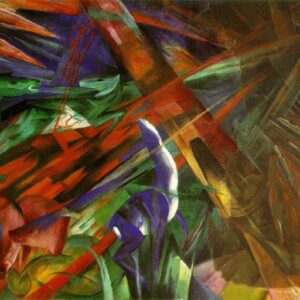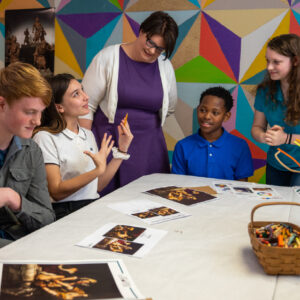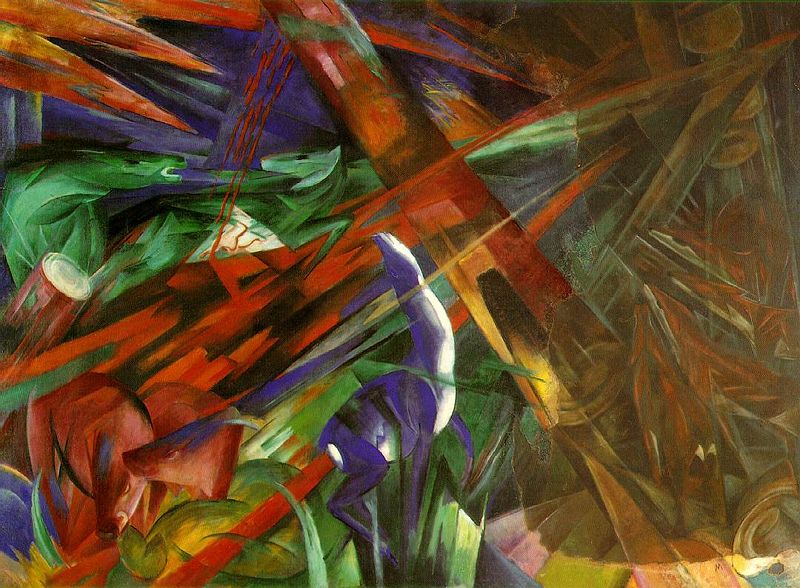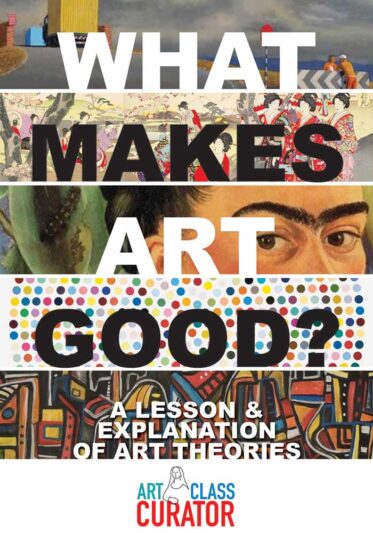Today’s artwork is one that has really captured my attention over the last year–Franz Marc Fate of the Animals. I’m not sure why I never really noticed it before, but ever since I had to write a lesson on German Expressionism last year, I can’t get this one out of my head. This powerful and jarring artwork created just before World War I is perfect for art analysis, creative writing, and teaching history with art.
As always, use these tips for how to look at art with kids. Always let them look and think about it before you give them any information!
Recommended Age: I think you could discuss this with upper elementary and older, but the learning activities included are best for upper middle school and high school students.
Fate of the Animals Discussion Questions
- What is going on in this painting? What do you see that makes you say that?
- What animals do you see? What is happening to them?
- What emotions do you feel when looking at this painting? What emotions do you think the artist was feeling?
- Describe the lines and colors in this painting. How do the colors and lines contribute to the emotion?
- How is the left side different from the right? Why do you think the artist did that? (Side note: I believe the dark brown on the left was from fire damage, but you can also discuss it as part of the meaning. You’re the boss.)
- What is the story being told?
- What do you think the artist was trying to say?
- On the back of this painting, the artist wrote, “Und Alles Sein ist flammend Leid” (“And all being is flaming agony”). How does this quotation contribute to the meaning you understood from this painting?

Free Resource!
Fate of the Animals Free Resource
This free lesson plan includes a look at the elements and principles used in ‘Fate of the Animals’ plus essential questions for a classroom discussion of the artwork.
Franz Marc Fate of the Animals Commentary
Fate of the Animals was painted just a year before the beginning of World War I. The jarring and intensely bright colors, the enormous size (77 x 105 inches), and the disturbing imagery of animals ripped apart and in pain mimic the uneasiness in Europe at this time. Although this painting was not created specifically about war, Franz Marc (the artist) himself wrote a letter from the war to his wife that said “[it] is like a premonition of this war—horrible and shattering. I can hardly conceive that I painted it.” To me, a figure in the top left seems to be the aggressor–perhaps a man or a machine–that destroys the trees and animals of the forest.
Whether it is about industrialization and the destruction of the forest or about the impending war, it is hard to separate Fate of the Animals from its sad story. The artist died fighting in the war and so did the art movement he helped found, Der Blaue Reiter. It is so sad that we will never know truly how Marc was impacted or what kind of art he would have made in response to his experience on the battlefield.
Curriculum Connections
History. Fate of the Animals is a great choice for studying World War I and the change from the peaceful and prosperous La Belle Époque to the devastation of The Great War. This painting allows you to connect with the emotions of war and how people felt during this time.
Learning Activities
1. Poetry. This painting is perfect for a poetry-writing exercise. It’s full of raw emotion and imagery which gives students a lot of opportunities to get creative with their writing. I have a post coming about poetry and art.
2. Composition Mapping / Formal Analysis. Fate of the Animals has a very strong use of diagonal lines which add to the energy and excitement of the picture. To help teach your students how to use lines to convey mood, have them trace the main directional lines of the painting on Fate of the Animals and another work with a lot of horizontal and vertical lines like The Last Supper by Leonardo da Vinci. There are a few ways to do this. You can print the image and place a transparency over it. Trace the main directional lines and then remove the artwork to just look at the lines. You could do the same using PowerPoint or Photoshop as well. Or you could use this image I made below.
This page from the Getty Museum is a great site to get started with formal analysis in art.
3. Write a Letter. Read above about how Franz Marc wrote a letter about this painting to his wife from the battlefields. Have your student write a letter from the battlefields explaining war. Or, have the student write a letter to Franz Marc asking him questions about his painting.
Related Resources*
- More Works by and Information about Franz Marc on the Artchive
- Understanding Formal Analysis, by the J. Paul Getty Museum
- Art Print of this Painting
- The Artist Who Painted a Blue Horse — Eric Carle book about this artist for the younger set.
- Book about Franz Marc — These Taschen artist books are great. They are thin and inexpensive with big pictures. I don’t have this one, but I have several others.
What do you think of Fate of the Animals? Is there an artwork you love that you’d like for me to cover in this series? Let me know in the comments!

Get the Full Lesson!
This Lesson is in The Curated Connections Library!
Find the full lesson from this post along with hundreds of other art teaching resources and trainings in the Curated Connections Library. Click here for more information about how to join or enter your email below for a free SPARKworks lesson from the membership!
This post was originally posted on April 28, 2014.








These are amazing! I will feature your post on our next Kids Learning linky party!
Awesome! Thank you so much! 🙂
This is such a fantastic resource thank you!
My 10 year old son has been so inspired, he has followed it up with more research on Marc, and has painted his own canvas based on Marc’s earlier works. One thing he mentioned whilst we looked at ‘The Fate of the Animals’ was the brown haze on the right of the painting. He said it was ‘like the poisonous gas in the trenches seeping into the picture and killing the tortured animals’.
How wonderful! This is one of my all time favorite paintings! I am so excited your son liked it too. What an amazingly insightful little guy! 🙂
Been drawn to Franz Marc somehow since I saw a tattered print thumb tacked next to my desk in second grade of his 3 Yellow Horses. ALWAYS haunting and powerful in my life….never really figuring the connection but maybe don’t need
to. Thank you for the resource!
What a wonderful story. Thanks for sharing. 🙂 It’s amazing how individual artworks can stick with us.